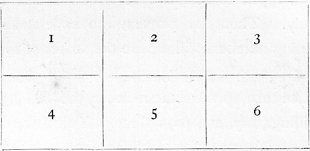
|
foreword to the online edition I. introductory II. common sharpers and their tricks III. marked cards and the manner of their employment IV. reflectors V. holdouts VI. manipulation VIII. the game of faro IX. prepared cards X. dice XI. high ball poker XII. roulette and allied games XIII. sporting houses XIV. sharps and flats
|
SHARPS AND FLATS
CHAPTER X DICE
SweatThis is a game which is almost as charmingly artistic as its name, and one which is particularly lovely for the banker. It also has the merit of extreme simplicity, and although cheating is hardly necessary as a rule, still there are times when it may be resorted to with great profit to the sharp. It is played with a layout arranged in the following manner: FIG. 59 The banker shakes up three dice in the box, and the numbers thrown win for the players. Those who have staked their money upon the numbers which have turned up receive the amount of their stakes; the bank takes all that has been laid upon the figures not represented in the throw. If two dice fall with the same number uppermost, those who have staked upon that number will receive twice the amount of their bets. If all three dice turn up the same, that number is paid three times over. It does not require a great mathematician to see that even at the best of times there is an overwhelming percentage of the chances in favor of the banker. It is five to three that he wins any individual bet; the player has only three chances those provided by the three dice, whilst the bank has the chances resting upon the remaining five squares of the layout. If we suppose, for example, that the bets upon all the squares are of an equal amount, which is just about the most unfortunate arrangement for the banker, the worst that can happen to him is that all three dice turn up differently. Then the players who have staked upon the winning numbers will receive the stakes of those who have lost, the bank gaining and losing nothing. If two of the dice turn up the same number, the banker receives four shillings, say, and pays three. If all three dice turn up the same, he pays three shillings and receives five. Cheating is introduced into this game by the banker in the case of a player persistently backing a high number time after time, the method being to ring in a dispatcher which will fall low. This will materially lessen the player's chances. If in addition to this a low number is secured upon one of the other dice, the chances against the player become five to one. If the player should happen to be backing a low number, of course a high dispatcher would be used and a high number secured upon the other die.
|
| « dice (Yankee-grab) | dice (hazard) » |
home | introduction | book content | links | advertising | contact
